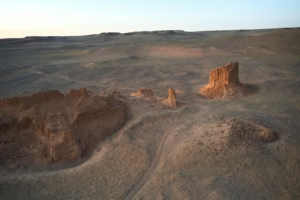
Bulgan, Ömnögovi, Mongolia , Gobi desert, photo by sungmu heo
Discovering Ravjaa ishiii: A New Mammal from the Late Cretaceous Gobi Desert
Scientists just discovered a new ancient mammal one that scurried around the feet of dinosaurs 100 to 66 million years ago! Found in Mongolia’s famous Gobi Desert, this mouse-sized fossil has been named Ravjaa ishiii, and it’s helping us piece together the hidden world of early mammals.

Bulgan, Ömnögovi, Mongolia Aerial view of cliffs in Gobi Desert in evening. Picture by ArtHouse Studio
This little creature, named Ravjaa ishiii, helps us understand how mammals survived during the “Age of Dinosaurs” (100-66 million years ago). While giant dinosaurs ruled the land, small mammals like this one were quietly evolving in the shadows.
The species name carries deep significance “Ravjaa“ honors Dulduityn Danzanravjaa, a revered 19th-century Buddhist monk, poet, and scholar from Mongolia.“Ishiii“ pays tribute to the late Kenichi Ishii, former director of the Hayashibara Museum of Natural Sciences, who played a crucial role in establishing the Mongolia–OUS (Okayama University of Science) research partnership.
This naming convention reflects both cultural respect and scientific collaboration, bridging Mongolia’s heritage with modern paleontological research.
This little mammal had teeth and a jaw unlike any found before so different that scientists realized it’s a completely new kind of animal. Before this, we thought its family (zhelestids) only lived near ancient coasts, but this discovery proves they also thrived deep inland.
It lived during a special time when flowering plants were just starting to spread. Its strong, tall teeth look like those of modern animals that eat seeds and fruits hinting that some early mammals may have already been snacking on these new plants.
Comparable to a modern mouse, suggesting it was a small, agile creature. Likely insectivorous or omnivorous, feeding on insects, plants, or small invertebrates. Lived in the arid to semi-arid environments of the Late Cretaceous Gobi Desert.
This study is published in the journal Acta Palaeontologica Polonica

